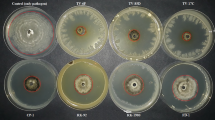Abstract
Bacillus licheniformis (EN74-1) was evaluated for the control of gray mold of apple caused byBotrytis mali. Dual culture, cell-free metabolite and volatile tests showed thatB. licheniformis (EN74-1) inhibited growth of the pathogen. Inhibition varied from 46.2% to 65.4% in the dual culture tests; 58.6% to 58.8% in the cell-free metabolite tests; and 28.4% to 33.8% in the volatile tests.B. licheniformis (EN74-1) appeared to be a good antagonist of gray mold on apples at 20° and 4°C. It reducedB. mali lesion diameter to 9–11 mm compared with to 32–41 mm in the control at 4°C. At 20°C the lesion diameter was reduced to 3.6–8.4 mm for the antagonistic treatment and to 25.8–38.2 mm for the control treatment after 14 days.
Similar content being viewed by others
References
Agerholm, J.S., Jensen, N.E., Giese, S.B. and Jensen, H.E. (1997) A preliminary study on the pathogenicity ofBacillus licheniformis bacteria in immunodepressed mice.Acta Pathol. Microbiol. Immunol. Scand. 105:48–54.
Bechard, J., Eastwell, K.C., Sholberg, P.L., Mazza, G. and Skura, B. (1998) Isolation and partial characterization of antimicrobial peptide produced by a strain ofBacillus subtilis.J. Agric. Food Chem. 46:5355–5361.
Bonaterra, A., Mari, M., Casalini, L. and Montesinos, E. (2003) Biological control ofMonilinia laxa andRhizopus stolonifer in postharvest of stone fruit byPantoea agglomerans EPS125 and putative mechanisms of antagonism.Int. J. Food Microbiol. 84:93–104.
Dennis, C. and Webster, J. (1971) Antagonistic properties of species group ofTrichoderma III. Hyphal interaction.Trans. Br. Mycol. Soc. 57:363–369.
Emmert, E.A.B. and Handelsman, J. (1999) Biocontrol of plant disease: a Gram-positive perspective.FEMS Microbiol. Lett. 171:1–9.
Etebarian, H.R., Sholberg, P.L., Eastwell, K.C. and Sayler, R.J. (2005) Biological control of apple blue mold withPseudomonas fluorescens.Can. J. Microbiol. 51:591–598.
Fiddaman, P.J. and Rossall, S. (1993) The production of antifungal volatiles byBacillus subtilis.J. Appl. Bacteriol 74:119–126.
Handelsman, J., Raffel, S.J., Mester, E.H., Wunderlich, L. and Grau, C.R. (1990) Biological control of damping-off of alfalfa seedlings withBacillus cereus UW85.Appl. Environ. Microbiol. 56:713–718.
Janisiewicz, W.J. and Korsten, L. (2002) Biological control of postharvest diseases of fruits.Annu. Rev. Phytopathol. 40:411–441.
Janisiewicz, W.J. and Marchi, A. (1992) Control of storage rots on various pear cultivars with a saprophytic strain ofPseudomonas syringae.Plant Dis. 76:555–560.
Janisiewicz, W.J. and Roitman, J. (1988) Biological control of blue mold and gray mold on apple and pear withPseudomonas cepacia.Phytopathology 78:1697–1700.
Jiang, Y.M., Zhu, X.R. and Li, Y.B. (2001) Postharvest control of litchi fruit rot byBacillus subtilis.Lebensm.-Wiss. Technol. 34:430–436.
Katz, E. and Demain, A.L. (1977) The peptide antibiotics ofBacillus: chemistry, biogenesis, and possible functions.Bacteriol. Rev. 41:449–474.
Korsten, L., Van Harmelen, M.W.S., Heitmann, A., de Villiers, E. and de Jager, E.S. (1992) Biological control of postharvest mango fruit diseases.S. Afr. Mango Growers’ Assoc. Yearb. 11:65–67.
Korzybski, T., Kowszyk-Gifinder, Z. and Kurytowicz, W. (1978) Antibiotics. Origin, Nature and Properties. American Society for Microbiology, Washington, DC.
Leibinger, W., Breuker, B., Hahn, M. and Mendgen, K. (1997) Control of postharvest pathogens and colonization of the apple surface by antagonistic microorganisms in the field.Phytopathology 87:1103–1110.
Little, T.M. and Hills, F.J. (1978) Agricultural Experimentation: Design and Analysis. John Wiley and Sons, New York, NY.
McHugh, R. and Seddon, B. (2000) Mode of action ofBrevibacillus brevis — biocontrol and biorational control.Proc. 6th IOBC/WPRS-EFPP Biocontrol Workshop (Seville, Spain), p. 19.
McLaughlin, R.J., Wilson, C.L., Droby, S., Ben-Arie, R. and Chalutz, E. (1992) Biological control of postharvest diseases of grape, peach, and apple with the yeastsKloeckera apiculata andCandida guilliermondii.Plant Dis. 76:470–473.
O’Gorman, D.T., Stokes, S. and Sholberg, P.L. (2005) Identification ofBotrytis mali within theBotrytis population causing fruit decay on apple in the orchards of British Columbia.Can. J. Plant Pathol. 27:468–469.
Pusey, P.L. and Wilson, C.L. (1984) Postharvest biological control of stone fruit brown rot byBacillus subtilis.Plant Dis. 68:753–756.
Roberts, R.G. (1990) Postharvest biological control of gray mold of apple byCryptococcus laurentii.Phytopathology 80:526–530.
Sadfi, N., Cherif, M., Fliss, I., Boudabbous, A. and Antoun, H. (2001) Evaluation ofBacillus isolates from salty soils andBacillus thuringiensis strains for the biocontrol ofFusarium dry rot of potato tubers.J. Plant Pathol. 83:101–118.
Singh, V. and Daverall, S.J. (1984)Bacillus subtilis as a control agent against fungal pathogens of citrus fruit.Trans. Br. Mycol. Soc. 83:487–490.
Viñas, I., Vallverdú, N., Monllao, S., Usall, J. and Sanchis, V. (1993) Imazalil resistantPenicillium isolated from Spanish apple packinghouses.Mycopathology 123:27–33.
Weller, D.M. (1988) Biological control of soilborne plant pathogens in the rhizosphere with bacteria.Annu. Rev. Phytopathol. 26:379–407.
Wilson, C.L., Franklin, J.D. and Pusey, P.L. (1987) Biological control ofRhizopus rot of peach withEnterobacter cloacea.Phytopathology 77:303–305.
Wisniewski, M.E. and Wilson, C.L. (1992) Biological control of postharvest diseases of fruits and vegetables: recent advances.HortScience 27:94–98.
Woodhead, S.H., O’Leary, A.L., O’Leary, D.J. and Rabatin, S.C. (1990) Discovery, development and registration of a biocontrol agent from an industrial perspective.Can. J. Plant Pathol. 12:328–331.
Zhou, T., Chu, C.L., Liu, W.T. and Schaneider, K.E. (2001) Postharvest control of blue mold and gray mold on apples using isolates ofPseudomonas syringae.Can. J. Plant Pathol. 23:246–252.
Author information
Authors and Affiliations
Corresponding author
Additional information
http://www.phytoparasitica.org posting Dec. 11, 2007.
Rights and permissions
About this article
Cite this article
Jamalizadeh, M., Etebarian, H.R., Alizadeh, A. et al. Biological control of gray mold on apple fruits byBacillus licheniformis (EN74-1). Phytoparasitica 36, 23–29 (2008). https://doi.org/10.1007/BF02980744
Received:
Revised:
Accepted:
Issue Date:
DOI: https://doi.org/10.1007/BF02980744




